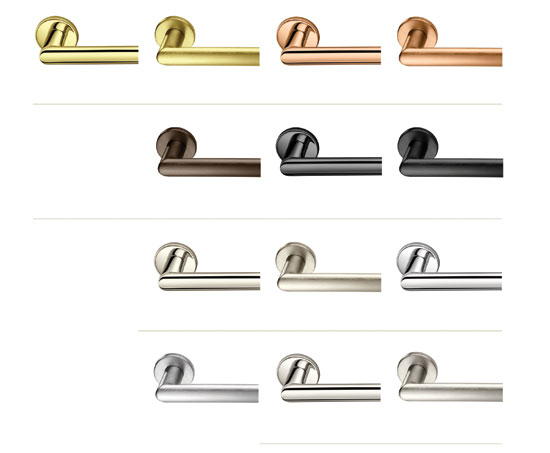Aesthetically Designed Architectural Door Openings
 |
Some available types of door hinges include (left to right) two-knuckle hinge with decorative tips, three-knuckle hinge with decorative tips, five-knuckle hinge, olive-knuckle hinge, and a square barrel hinge. Photos courtesy of ASSA ABLOY |
Hinges of all types can be fabricated in a variety of metals and finished in virtually any common metal coloring. They can also be fabricated to be more secure by virtue of having less ability to be disassembled either through the fasteners used or by design of the hinge itself. In either case, choices are available that will allow for exposed parts of hinges to blend with or complement a finished design aesthetic. In cases where this hardware is not desired to be exposed, then concealed hinges or pivots will be the best option.
One other consideration in hanging doors is that perhaps a hinged door is not the way to go at all. Rather, a sliding door may be more suitable in one of three varieties. A fully concealed sliding door will have a track and hardware that are pre-assembled and concealed within a wall as is common in residential and some light commercial applications. Alternatively, two sliding doors may overlap or the door may overlap an adjacent panel with the track and sliding mechanism covered over. Thirdly, a barn door style of slider is common in commercial and industrial settings with the door set to slide in front of a wall and cleanly close off an opening. In those cases the hardware will most likely be exposed but can be selected in a variety of styles that are either traditional or modern.
Securing Devices—Point of Contact
As mentioned earlier, hardware that is used to operate or secure a door is an integral part of experiencing a space. Since this is the point where we actually touch the building, it is also a point that we look at directly to understand how to operate it. That experience can be enhanced by the clarity of the aesthetics of the hardware or be diminished by a lack of aesthetics and integration.
The primary factor that drives the decision on what hardware to use is the intended function of the door. The overall term that describes the locking hardware on a door is the lockset which is typically made up of multiple pieces, both visible to the user and concealed inside. The lockset can be specified to function in a number of ways including:
• Entry function: Typically used on primary exterior doors, this type of locking set has operable handles with a keyed cylinder on the exterior side of the door and normally a turn piece on the interior side. Double cylinder sets are available that have a keyed cylinder on both sides of the door.
• Dummy function: A single dummy set has inoperable handles on one side of the door, while a full dummy set has fixed handles on both sides of the door. Dummy sets are typically used in conjunction with roller catches, flush bolts, or surface bolts.
• Push/pull function: A push/pull set has inoperable grip handles and/or escutcheons and can have locking mechanisms in single cylinder, double cylinder, or patio applications.
 |
Door hardware is available in a range of metal colors and finishes. Images courtesy of ASSA ABLOY |









